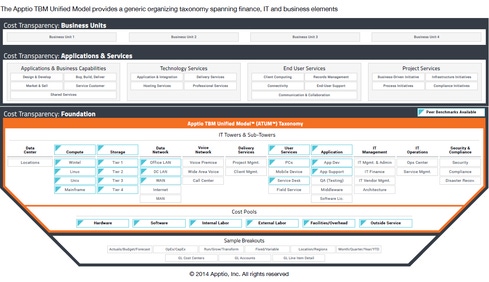You're all over collecting and mining information to help the business get lean and mean. Why not shine that light inward?


Geek's Guide To NYC Travel: Interop Preview
Geek's Guide To NYC Travel: Interop Preview (Click image for larger view and slideshow.)
At a recent CIO Summit hosted by Extreme Networks at Gillette Stadium, home of the New England Patriots, IT executives from all four major Boston teams joined the CIO of the NFL, Michelle McKenna-Doyle, and tech leaders from major universities. The topic? Using big data in innovative ways in their organizations.
These IT pros sweat every detail of the fan or student experience. For the teams, that means using data to watch season ticket re-ups like hawks. These ticket holders tend to trend older, says Jessica Gelman, VP of customer marketing & strategy at Kraft Sports Group, owner of the Pats. The teams know a giant TV and comfy chair can be awfully alluring compared with costly concession food, snarled traffic, and in the case of the Patriots, often bone-chilling cold. The education CIOs are just as focused on experience. Joanna Young, VP & CIO of Michigan State University, tracks data including clubs joined and attendance at sporting events to predict the retention of freshmen. Michael Mathews, CIO of Oral Roberts University, is championing an Education and Career Positioning System project using the Department of Education's Open Data Initiative to put information into the hands of students and their families.
Of course, big data and metrics are used way beyond sports and education. IT's championed the Lean methodologies that have sucked the last ounce of fat from manufacturing operations. Advanced CAD systems keep a sharp eye on engineering teams designing everything from bridges to electronics. Salespeople are rated not just on closed deals but the velocity of sales and potentially dozens more criteria. CMOs track KPIs like reach, conversion, and returns on campaigns. A doctor didn't wash her hands often enough? Some hospital admin, somewhere, knows it, thanks to technology.
IT has gleefully helped companies use metrics to give other employees and business units the equivalent of a 24/7/365 proctology exam.
Now if only enterprise CIOs were willing to turn that data-driven lens on their own operations. Think about the IT project fiascos you've been personally involved in. Oracle's very public feud with Oregon over the failure of the state's insurance exchange is just the latest high-stakes debacle. State tech leaders tried hard to push blame onto Oracle but, as my colleague David Carr reports, the exchange failed to process even a single self-service application. That's a leadership failure of the sort that wouldn't be tolerated in any other business unit. Yet many CIOs shrug and say, essentially, "Hey, technology is complicated. Stuff happens."
[Service-Oriented IT: Millions of dollars and years of work have gone into ITSM and ITIL. Was it all worth it? Jonathan Feldman investigates.]
Chris Pick, president of the nonprofit Technology Business Management Council and a speaker at Interop New York, says the time has come for IT leaders to turn the IT benchmarking lens on IT itself. The result would be cost transparency and the ability to prove IT's value with hard numbers. Heck, maybe the business should be spending more on technology.
"Every publicly traded company today is evaluated from a performance perspective on generally accepted accounting principles" that standardize metrics like income statements, balance sheets, cash flows, and changes in equity, says Pick. "Those statements provide an apples-to-apples comparison. IT's never had that."
The TBM Council provides an open-source framework to bring this rigor to technology leaders. The goal? "Managing IT with business discipline," says Pick.
The council's Unified Model (see diagram, below) breaks IT into 12 areas: data center, compute, storage, data network, voice network, delivery services (project management), user services, applications, IT management, IT operations, and security & compliance. Within each area are cost pools: hardware, software, internal and external labor, facilities/overhead, and outside service. "All of those can be standardized," says Pick.
It's not that there's no accounting now. But it's too general and not up to the task of metrics-driven decision-making. "Every organization, right now, manages their IT department with a general ledger," he says. "Those general ledgers are insufficient in developing a way to make decisions."
Using the unified model, a company could compare outlays granularly, in standard cost pools, and benchmark against peers in a way that makes sense to the CFO. "Say you're GE, you might want to find another global conglomerate that has an IT spend of $2 billion and does durable goods manufacturing," says Pick.
Right now the TBM has more than 1,300 members, from banking to healthcare, all of which have contributed to developing the model. That means they've provided the kind of transparency that sales, manufacturing, and other areas of the business have taken for granted for years. Apptio, a technology business management software company for which Pick serves as CMO, has also applied the model to several hundred customers.
A static accounting isn't the endgame, either. Pick says the TBM Council's goal is to automate so that at any time the business can check current metrics for IT service delivery by understanding the cost of components, just like any supply chain. It's also not looking to do the kind of qualitative, point-in-time assessments consultancies like Gartner make their money on. Pick says benchmarks need to be quantitative, driven by facts and data.
"The 'poor man's benchmarking' today is, 'Where am I against Amazon for cost of compute, or the cost per gigabyte of storage through Rackspace?'" he says. "Businesses are now asking, 'Why are we materially higher?' That's where the data is so important." Cloud has educated the business and supplied competition. Unless IT can justify why storage costs twice as much internally, what makes us think the business will keep letting us manage it?
Maybe you've developed very specific security controls that will protect shareholders. You know it; now quantify it. Of course, security has always lagged in terms of standardization. You can't even know for sure it's successful, much less price it on a per-port or per-MB basis. Pick admits this is one area where work needs to be done, but says we can't wait. "The discussion of running IT as a business is driven by the business demanding that visibility."
The excuses why quantitative benchmarking of IT services will never work are, of course, myriad. It's too complicated. Technology changes too fast. We don't have time. The business doesn't care.
What it boils down to is: Many IT shops are scared. What should be more scary is that cloud is coming. Can you prove that you can deliver services better? Metrics let IT and the business have an unemotional discussion about what's paying off -- and what isn't.
"Start small, but start," says Pick. "Information sets you free." Maybe just benchmark fixed vs. variable, or run vs. grow or transform. "You can't manage what you can't measure."
In its ninth year, Interop New York (Sept. 29 to Oct. 3) is the premier event for the Northeast IT market. Strongly represented vertical industries include financial services, government, and education. Join more than 5,000 attendees to learn about IT leadership, cloud, collaboration, infrastructure, mobility, risk management and security, and SDN, as well as explore 125 exhibitors' offerings. Register with Discount Code MPIWK to save $200 off Total Access & Conference Passes.
About the Author(s)
You May Also Like







